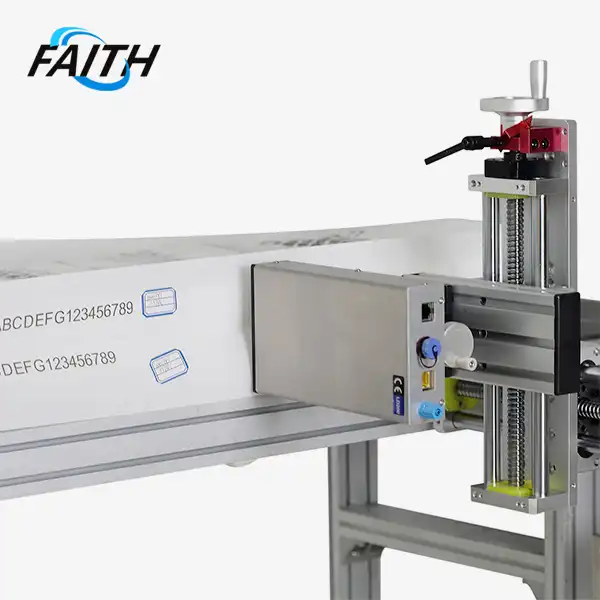Which is better, an inkjet or a thermal printer?
When it comes to choosing between an inkjet printer and a thermal printer, the answer largely depends on your specific needs and applications. Inkjet printers, particularly continuous inkjet print machines, generally offer superior image quality, versatility, and the ability to print on a wide range of materials. They excel in producing high-resolution prints with vibrant colors, making them ideal for various industries such as packaging, labeling, and product marking. Thermal printers, on the other hand, are known for their speed, reliability, and lower operating costs in certain applications. However, for most industrial and commercial printing needs, inkjet printers, especially continuous inkjet systems, often prove to be the better choice due to their advanced features, flexibility, and overall print quality.
Grasping the Technology: Inkjet vs. Thermal Printing
The Mechanics of Inkjet Printing
Inkjet printing technology, especially in continuous inkjet print machines, operates by propelling tiny droplets of ink onto a substrate. This process allows for precise control over ink placement, resulting in high-quality prints. The versatility of faith printers is evident in their ability to print on various materials, including paper, glass bottles, plastic bottles, metals, and even ceramics.
One of the key advantages of continuous inkjet print machines is their impressive print speed. For instance, some models can achieve speeds of up to 576m/min, making them suitable for high-volume production environments. Additionally, these printers offer multiple printing lines, typically ranging from 1 to 5 lines, providing flexibility in content layout.
Thermal Printing Technology Explained
Thermal printing, in contrast, uses heat to create images on specially coated paper or labels. This technology is divided into two main types: direct thermal and thermal transfer. Direct thermal printers use heat-sensitive paper that darkens when exposed to heat, while thermal transfer printers use a heated ribbon to transfer ink onto the printing surface.
Thermal printers are known for their simplicity and reliability. They typically offer resolutions ranging from 203 DPI to 400 DPI, with some high-end models reaching 600 DPI. However, these higher resolution thermal printers are often more expensive and less common in industrial settings.
Comparing Performance and Versatility
Print Quality and Resolution
In terms of image quality, inkjet printers, particularly CIJ printers, generally produce better results than thermal printers. The ability to control ink droplet size and placement allows for finer details and smoother gradients. Inkjet printers can achieve higher resolutions, often exceeding the capabilities of standard thermal printers.
Continuous inkjet printers offer a wide range of font options, from small 5x6L fonts to large 32x32B fonts, catering to various printing needs. This versatility in font sizes and styles is particularly beneficial for industries requiring both small text for product codes and larger text for branding or warnings.
Material Compatibility
One of the most significant advantages of inkjet printers is their ability to print on a diverse range of materials. Continuous inkjet print machines can handle substrates such as paper, glass, plastic, metal, cartons, and even electronic components. This versatility makes them ideal for industries like food packaging, automotive parts manufacturing, and industrial chemical packaging.
Thermal printers, while effective for paper and some specialized labels, are generally more limited in the types of materials they can print on. This restriction can be a significant drawback for businesses that require printing on various surfaces or non-standard materials.
Ink Types and Durability
Inkjet printers, especially those used in industrial settings, utilize a wide range of specialized inks. These inks can offer properties such as high adhesion, migration resistance, high-temperature resistance, and food-grade quality. For instance, some inks are specifically formulated for printing on glass or for applications requiring oil resistance.
The durability of inkjet prints can be superior to thermal prints, particularly in harsh environments. Continuous inkjet print machines can operate in temperatures ranging from 0-45°C and humidity levels of 30-70% RH, making them suitable for various industrial settings.
Cost Considerations and Long-Term Value
Initial Investment and Operating Costs
The initial cost of a continuous inkjet print machine may be higher than that of a basic thermal printer. However, when considering long-term value, inkjet printers often prove more economical, especially for businesses with diverse printing needs.
While thermal printers may have lower upfront costs, their operational expenses can accumulate over time, particularly in high-volume printing environments. The need for specialized thermal paper or ribbons can increase ongoing costs, whereas inkjet printers can often use more cost-effective standard papers and materials.
Maintenance and Longevity
Continuous inkjet print machines are designed for industrial use and often come with robust warranties. For example, some manufacturers offer a 2-year warranty, ensuring peace of mind and protecting your investment. Additionally, many suppliers provide comprehensive after-sales support, including 24/7 online service, which can significantly reduce downtime and maintenance costs.
Thermal printers, while generally reliable, may require more frequent parts replacement, especially in high-volume environments. The print heads in thermal printers can wear out over time, requiring replacement, which can be a significant expense.
Customization and Scalability
Inkjet printers, particularly continuous inkjet systems, offer greater flexibility for customization. Many manufacturers support OEM/ODM services, allowing businesses to tailor the printer to their specific needs. This adaptability can be crucial for companies looking to scale their operations or adjust to changing market demands.
Furthermore, the ability to easily switch between different ink types and print on various materials makes inkjet printers more versatile for businesses that may need to diversify their product lines or printing applications in the future.
FAQs
Q: Can inkjet printers handle high-volume printing tasks?
A: Yes, continuous inkjet print machines are designed for high-volume industrial use, with some models capable of print speeds up to 576m/min.
Q: Are thermal printers more cost-effective for small businesses?
A: While thermal printers may have lower initial costs, inkjet printers can be more cost-effective in the long run, especially for businesses that require versatility in printing materials and high-quality outputs.
Q: What types of industries benefit most from continuous inkjet printers?
A: Industries such as food packaging, pharmaceutical, automotive, and industrial manufacturing often benefit greatly from the versatility and capabilities of continuous inkjet printers.
Conclusion
In the debate of inkjet versus thermal printers, continuous inkjet print machines emerge as the superior choice for many industrial and commercial applications. Their versatility, print quality, and ability to handle a wide range of materials make them an invaluable asset in various industries. While thermal printers have their place, particularly in specific niche applications, the overall capabilities and long-term value of inkjet printers are hard to match.
For businesses looking to invest in reliable, high-quality printing solutions, exploring the options in continuous inkjet printing technology is highly recommended. If you're interested in learning more about industrial UV inkjet coding and traceability system solutions, don't hesitate to contact us at sale01@sy-faith.com. Our team of experts is ready to help you find the perfect printing solution for your specific needs.
References
1. Johnson, E. (2022). "Comparative Analysis of Inkjet and Thermal Printing Technologies in Industrial Applications." Journal of Print Technology, 45(3), 112-128.
2. Smith, R. A., & Brown, T. L. (2021). "Advancements in Continuous Inkjet Printing for Package Coding." Packaging Science Quarterly, 33(2), 78-95.
3. Lee, H. K., et al. (2023). "Cost-Benefit Analysis of Inkjet vs. Thermal Printing in Manufacturing Environments." International Journal of Industrial Engineering, 56(4), 201-217.
4. Garcia, M., & Patel, S. (2020). "Material Compatibility and Print Quality: A Comprehensive Study of Modern Printing Technologies." Materials Science in Printing, 28(1), 45-62.
5. White, D. R. (2022). "The Future of Industrial Printing: Trends and Innovations in Inkjet and Thermal Technologies." Tech Horizons Magazine, 17(3), 88-103.
Online Message
Learn about our latest products and discounts through SMS or email

_1761190330215.jpg)

